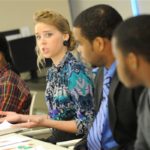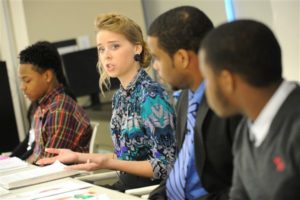
Students at six schools from across the country are taking part in a pilot program that uses “service learning” as a way to revitalize their schools and communities while gaining valuable 21st-century skills.
The Service & Technology Academic Resource Team (START) program, launched by the Corporation for National and Community Service (CNCS) and Microsoft Corp., aims to create a new kind of collaboration between students and teachers through technology-focused service learning.
CNCS and Microsoft chose six schools to participate in the program initially. The schools—Winston Churchill Middle School in California, Tupelo Middle School in Mississippi, Lower East Side Preparatory High School in New York, East Garner Magnet Middle School in North Carolina, Parkway West High School in Pennsylvania, and Forest Park High School in Virginia—will receive grants and serve as national test sites for how schools can integrate service learning and technology into the classroom.
Finding good programs and working to bring them to scale is something Mary Cullinane, director of innovation for U.S. Education at Microsoft, said is vital.
“We can’t constantly create the wheel. We need to look around the country to see who’s doing something that works and help them duplicate it,” she said at the Jan. 25 START launch. “Our job is to figure out ways to take what these schools are doing and make sure it’s not the exception.”
Karen Cator, director of education technology for the U.S. Department of Education, echoed Cullinane.
“Things that work need to be brought to scale. We need to spread these [programs] far and wide so that every school will have access to them,” she said.
Service-learning activities let students serve their communities within the framework of their curriculum, said Elson Nash, acting director of Learn and Serve America with CNCS.
“21st-century skills are often not measurable on a test. Those children who master those skills will be the ones to get the jobs in the future,” he said.
Jessica Decker, a student at Forest Park High School, said participating in service-learning projects has given her a clearer view of the world beyond school, something she said has changed the way she envisions her future.
Forest Park partnered with Students Working to Advance Technology to participate in the “Bridging the Gap” project, which has students rebuild and refurbish donated computers that are then donated to elementary, middle, and high school students who need them.
Decker said that while she originally hoped to be a fashion designer and have her own boutique in the future, she now looks at things from a global perspective.
“I want [my business] to be huge, and then I can look at ways to give a portion of the proceeds to charity,” she said.
Parkway West High School partnered with the Urban Technology Project to create a program in which students provide technology support. Their UrbanTech Program (UTP) is designed within a “cascading mentoring framework” in which higher-education students and UTP staff—which includes AmeriCorps VISTA members and Digital Service Fellows—serve as mentors and tutors to urban youth.
Taking part in service-learning programs such as the one at Parkway West has given students the skills they need to become leaders in their communities.
“I’m working to become a leader. When I teach others, I also learn a lot from them,” said Nafis Bey, a student at Parkway West.
Ni Fang, who participates in Lower East Side Preparatory (LESP) High School’s “Making Opportunities for Upgrading Schools and Education” program, which enables students to provide tech support for their school, agreed with Bey. LESP is a bilingual Chinese school.
“Service learning is important because we’re helping others, but we’re also learning ourselves,” said Fang, a Chinese immigrant. “Never think that you are wasting time when you are serving someone, because you are always getting something back. Like a Chinese old saying says, you can get happiness from helping others.”
Links:
Corporation for National Community Service
Students at six schools across the country are using service-learning as a way to not only revitalize their schools and communities, but gain valuable 21st century skills as well, through the new Service & Technology Academic Resource Team (START) program.
The program, launched by the Corporation for National and Community Service (CNCS) and Microsoft Corp., was established as a way to redefine the role of the student in the classroom while creating a new kind of collaboration between students and teachers through technology-focused service-learning.
CNCS and Microsoft selected six schools to participate in the program, which recognizes their scalable best practices. The schools–Winston Churchill Middle School in California, Tupelo Middle School in Mississippi, Lower East Side Preparatory High School in New York, East Garner Magnet Middle School in North Carolina, Parkway West High School in Pennsylvania, and Forest Park High School in Virginia–will receive grants and serve as national laboratory sites and as examples of how schools can integrate service-learning and technology into the classroom.
Finding good programs and working to bring them to scale is something Mary Cullinane, director of innovation for U.S. Education at Microsoft, said is vital.
“We can’t constantly create the wheel. We need to look around the country to see who’s doing something that works and help them duplicate it,” she said at the Jan. 25 START launch. “Our job is to figure out ways to take what these schools are doing and make sure it’s not the exception.”
Director of Education Technology for the U.S. Department of Education Karen Cator, who interviewed START school representatives, echoed Cullinane.
“Things that work need to be brought to scale. We need to spread these [programs] far and wide so that every school will have access to them,” she said.
Service-learning activities let students engage service with their academic curriculum, said Elson Nash, acting director of Learn and Serve America with CNCS.
“21st-century skills are often not measurable on a test. Those children who master those skills will be the ones to get the jobs in the future,” he said.
Jessica Decker, a student at Forest Park High School, said participating in service-learning projects has given her a clearer view of the bigger picture, something she said changed the way she envisioned her future.
Forest Park partnered with Students Working to Advance Technology to participate in the Bridging the Gap project, which has the students rebuild and refurbish donated computers, which are then donated to elementary, middle, and high-school students.
Decker said while she originally hoped to create fashion and have her own boutique in the future, she now looks at things from a global perspective.
“I want [my business] to be huge and then I can look at ways to give a portion of the proceeds to charity,” she said.
Parkway West High School partnered with the Urban Technology Project and created a program that enables students to provide technology support. Their UrbanTech Program (UTP) is designed in a “cascading mentoring framework” where higher education students and UTP staff, which includes AmeriCorps, AmeriCorps VISTA members, and Digital Service Fellows, serve as mentors and tutors to urban youth.
Taking part in service-learning programs such as the one at Parkway West also has given students the skills they need to become leaders in their communities.
“I’m working to become a leader. When I teach others I also learn a lot from them,” said Nafis Bey, a student at Parkway West.
Ni Fang, who participates in Lower East Side Preparatory (LESP) High School’s Making Opportunities for Upgrading Schools and Education program, which enables students to provide technical support to the school, agreed with Bey. LESP is a bilingual Chinese school.
“Service-learning is important because we’re helping others, but we’re also learning ourselves,” said Fang, a Chinese immigrant. “Never think that you are wasting time when you are helping someone else because you are getting something back. [It’s like a] Chinese saying: ‘happiness is helping others.'”
Links:
START project details
Corporation for National Community Service
http://www.nationalservice.gov/
Microsoft Corp.
- 3D equipment helps school lessons take on a whole new dimension - September 3, 2010
- IETF: AT&T’s net neutrality claim is ‘misleading’ - September 3, 2010
- To boost security, Facebook adds remote logout - September 3, 2010


Comments are closed.